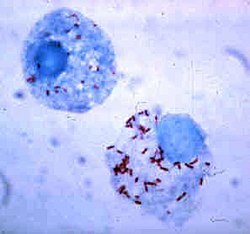Rickettsiales
| Rickettsias | |
|---|---|

| |
| Rickettsia rickettsii | |
| Scientific classification | |
| Kingdom: | |
| Phylum: | |
| Class: | |
| Subclass: | Rickettsidae
|
| Order: | Rickettsiales Gieszczkiewicz, 1939
|
| Families | |
The Rickettsiales, also called rickettsias, are an order of small proteobacteria. Most of those described survive only as endosymbionts of other cells. Some are notable pathogens, including Rickettsia, which causes a variety of diseases in humans. On the other end of the scale, genetic studies support the endosymbiotic theory according to which mitochondria and related organelles developed from members of this group. Some have also speculated that viruses might have developed from them, or from organisms like them.
The Rickettsiales are among the most mysterious groups of Proteobacteria, owing largely to difficulties in cultivating them. The group includes all obligate endosymbiont bacteria. However, a number of species have been removed, such as Coxiella burnetii, the cause of Q fever.
The Rickettsiales has a sister order the Pelagibacterales, which is composed of free living bacteria with extremely streamlined genomes. Prior to the cultivation of the Pelagibacterales type-species, Pelagibacter ubique, this order was known solely via metagenomic data and was known as SAR11 clade and was a member of the Rickettsiales. The relation between the two order is retained in the subclass, the Rickettsidae, which include the Rickettsiales, the Pelagibacteriales and the extinct protomitochondrion (mitochondria themselves are not bacteria, but organelles).[2]
The Holosporaceae was once a family in the Rickettsiales, but has since been placed in its own order, the Holosporales, which most likely is not as close to the Rickettsiales as initially believed, instead it is a basal order to the sister subclass of the Rickettsidae, the Caulobacteridae.[2]
| Schematic ribosomal RNA phylogeny of Alphaproteobacteria | ||||||||||||||||||||||||
| ||||||||||||||||||||||||
| The cladogram of Rickettsidae has been inferred by Ferla et al. [3] from the comparison of 16S + 23S ribosomal RNA sequences. |
References
- ^ Garrity, George (2005). Bergey's Manual of Systematic Bacteriology. Springer. ISBN 0-387-24145-0.
- ^ a b Ferla, M. P.; Thrash, J. C.; Giovannoni, S. J.; Patrick, W. M. (2013). "New rRNA gene-based phylogenies of the Alphaproteobacteria provide perspective on major groups, mitochondrial ancestry and phylogenetic instability". PLoS ONE. 8 (12): e83383. doi:10.1371/journal.pone.0083383. PMC 3859672. PMID 24349502.
{{cite journal}}: CS1 maint: unflagged free DOI (link) - ^ Ferla MP, Thrash JC, Giovannoni SJ, Patrick WM (2013). "New rRNA gene-based phylogenies of the Alphaproteobacteria provide perspective on major groups, mitochondrial ancestry and phylogenetic instability". PLOS ONE. 8 (12): e83383. Bibcode:2013PLoSO...883383F. doi:10.1371/journal.pone.0083383. PMC 3859672. PMID 24349502.
